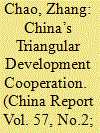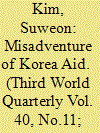| Srl | Item |
| 1 |
ID:
178419


|
|
|
|
|
| Summary/Abstract |
Triangular development cooperation (TDC) is an increasingly popular modality in the aid field. It is seen to have both huge potential and limits. As the largest emerging donor, China’s participation in TDC has been put under the spotlight. This article proposes a working definition of TDC focused on the type of resources transferred, and establishes a data set on the projects that China was involved in, from 2005 to 2016. Moreover, it investigates China’s perception of the TDC by analysing its official publications. It finds that (a) China holds an equivocal understanding of the TDC concept; (b) although China has been rhetorically stressing the importance of TDC, few real actions have been taken; (c) China prefers international organisations in TDC instead of traditional donors; and (d) like other actors, most of China’s TDC projects are recorded in non-economic sectors. At the moment, China remains cautious regarding the modality. But considering the growing volume of Chinese aid and its visibility, a more proactive stance on TDC might better serve Chinese interests.
|
|
|
|
|
|
|
|
|
|
|
|
|
|
|
|
| 2 |
ID:
113945


|
|
|
|
|
| Publication |
2012.
|
| Summary/Abstract |
South Korea, the newest member to join the OECD's Development Assistance Committee, has signaled that it will become a major donor of official development assistance (ODA). Having had its own history of being a large recipient of ODA, South Korea claimed that it will provide aid from the recipient's perspective. Using panel data covering twenty-three years (1987-2009) and 154 recipient countries, we examine whether South Korea's ODA reflects the recipient nation's humanitarian needs more than the donor's interests. We ask three questions: (1) What are the major determinants of South Korea's ODA allocation? (2) Has South Korea's ODA policies changed over different time horizons-that is, years, political regimes? (3) Does South Korea exhibit different standards of allocating ODA for different groups of recipient countries? We find that South Korea provides more aid to higher-income developing countries with higher growth rates, which shows the tendency o t serve the donor's economic interests. When we examine the data by time periods, we do not find significant differences over decades or political regimes. However, when we reexamine the data based on recipients' income levels, we find that the relationship between per capita income of the recipient country and ODA allocation is negative only for the middle-income or lower-middle-income group recipients and positive for the rest. This finding suggests the possibility that South Korea's ODA policy may have a dual-track structure.
|
|
|
|
|
|
|
|
|
|
|
|
|
|
|
|
| 3 |
ID:
168488


|
|
|
|
|
| Summary/Abstract |
Korea Aid was a development project delivering Korean medical services, food and pop music via trucks to rural communities in Africa. The project was poorly conceived, vulnerable to corruption and ultimately ineffective. While Korea Aid marked a backward step for Korea’s development cooperation, revealing many of the challenges associated with emerging donors, it also reflected Korea’s aspiration to become a cultural and developmental alternative to hegemonic nations. This paper examines the historical circumstances that led to the formation of Korea Aid, and further argues that Korea Aid embodied a synthesis of ‘cultural soft power’ and ‘developmental soft power’ intended to create the perception of Korea as culturally and developmentally attractive and benign. Korea’s current pursuit of developmental soft power intentionally transforms the country’s development experience into a ‘politically odourless’ model, masking its authoritarian undercurrent and in turn camouflaging growing aspirations to expand its global influence.
|
|
|
|
|
|
|
|
|
|
|
|
|
|
|
|